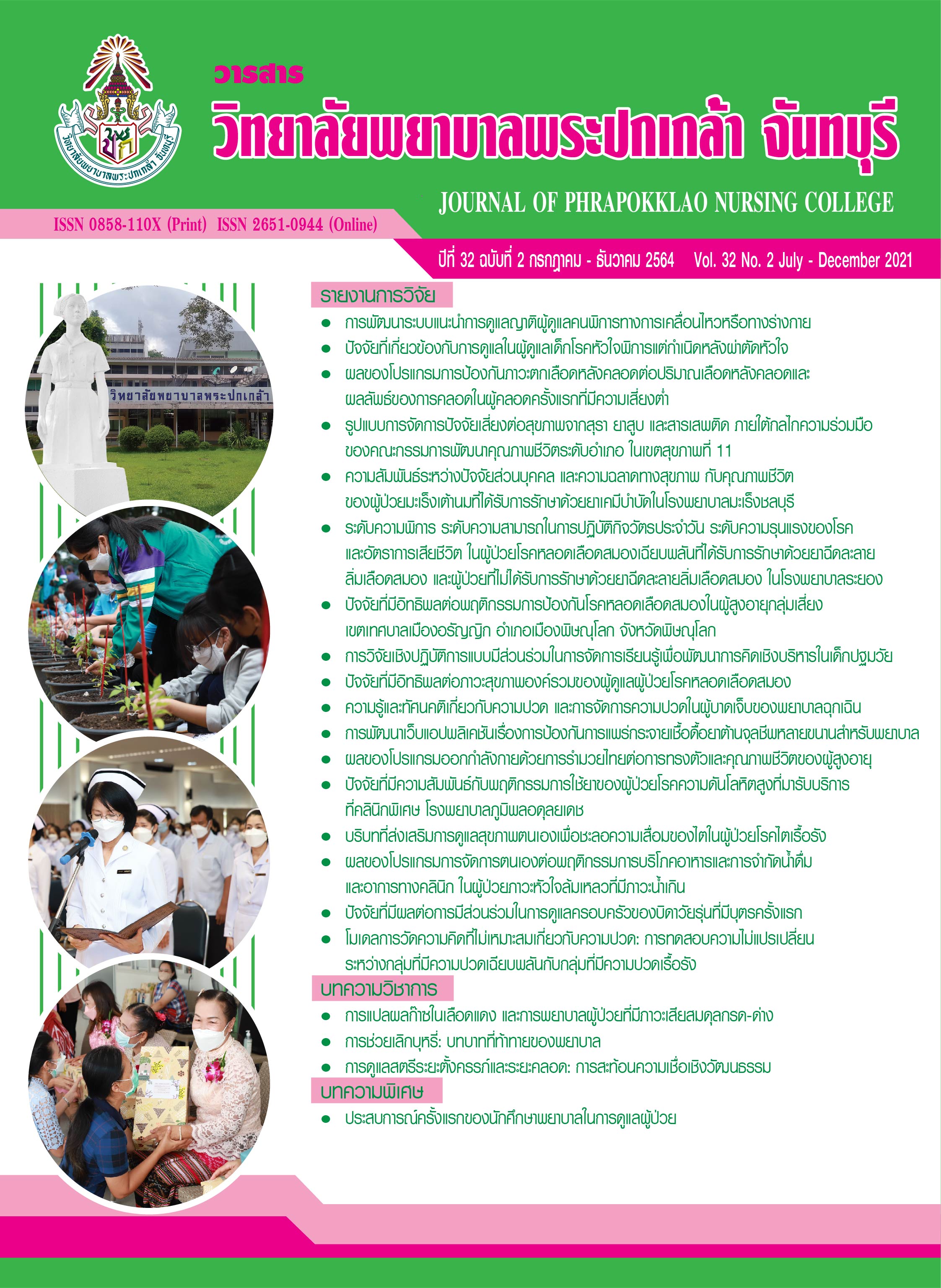The Development of a Caring Recommender System for Family Caregivers of Persons with Mobility or Physical Disability
Keywords:
Family caregiver, Persons with mobility or physical disability, Caring recommender system, Health technologyAbstract
This research and development aimed to develop a Caring Recommender System for Family Caregivers of Persons with Mobility or Physical Disability. There were four steps of the development: 1) a studying the feasibility and requirements for developing the recommender system by using a semi-structured interview with 15 purposive selected experts in nursing education, nursing administration, nursing practice, other health care practices, and health program development; 2) an creating the recommender system by applying technology, literature review, and data sets under the context of Thai society; 3) a testing the efficacy and satisfaction of the recommender system by using the efficacy and satisfaction assessment questionnaire with 60 purposive selected community nurses; and 4) an improving the version of the recommender system according to suggested. The qualitative data were analyzed using content analysis. The quantitative data were analyzed using descriptive statistics.
The research results founded that “the Caring Recommender System for Family Caregivers of Persons with Mobility or Physical Disability” is a health technique that was created to address the user performance to make their nursing care more easily. There are two components of the system: 1) the database management at the server and 2) the web-based presentation of the system, through the online recording of personal data of the family caregivers and health-related factors, the health risk analyzing by expert and neural network systems, and the recommendation providing for nurses to care for the family caregiver individually. After the trial, that the overall system efficiency was rated at very high level (M = 4.53, SD = .71) with the highest score of processing speed (M = 4.69, SD = .55), followed by accuracy (M = 4.51, SD = .69) and serviceability (M = 4.42, SD = .89), respectively. The overall system satisfaction was at a high level (M = 4.32, SD = .84), with content satisfaction more than presentation satisfaction (M = 4.45, SD = .72 and M = 4.22, SD = .96, respectively).
This research results reflect that “the Caring Recommender System for Family Caregivers of Persons with Mobility or Physical Disability” was useful in nursing planning for the care of family caregivers of persons with mobility or physical disabilities. Therefore, this system should be encouraged to be actively used by nurses, especially community nurses in order to improve quality of nursing care that is consistent with the problems and needs of each caregiver. This leads to the health of the family caregiver and the ability to maintain a role in caregiving for persons with mobility or physical disability.
References
กรมส่งเสริมและพัฒนาคุณภาพชีวิตคนพิการ กระทรวงการพัฒนาสังคมและความมั่นคงของมนุษย์. (2563). รายงานข้อมูลสถานการณ์ด้านคนพิการในประเทศไทย. สืบค้นจาก http://nadt.or.th/en/stat60.html
ณัชศฬา หลงผาสุข, สุปรีดา มั่นคง, และยุพาพิน ศิรโพธิ์งาม. (2561). ภาวะสุขภาพ และการดูแลตนเองของญาติผู้ดูแลวัยสูงอายุที่ดูแลผู้สูงอายุที่ติดเตียง. วารสารสภาการพยาบาล, 33(2), 97–109.
ธานินทร์ ศิลป์จารุ. (2560). การวิจัยและวิเคราะห์ข้อมูลทางสถิติด้วย SPSS และ AMOS (พิมพ์ครั้งที่ 17). กรุงเทพฯ: บิสซิเนสอาร์แอนด์ดี.
ปองพล นิลพฤกษ์, และกีรติบุตร กาญจนเสถียร. (2560). ระบบแนะนำกิจกรรมสําหรับการลดน้ำหนักโดยการประยุกต์ใช้ฐานความรู้แบบออนโทโลยี. วารสารวิจัยราชมงคลกรุงเทพ, 11(1), 8–16.
วิไล คุปต์นิรัติศัยกุล, พวงแก้ว ธิติสกุลชัย, สุพิน สาริกา, และศิริลักษณ์ แก้วนารี. (2561). ภาระของผู้ดูแลผู้ป่วยโรคหลอดเลือดสมอง 1 ปี หลังจําหน่ายออกจากโรงพยาบาล: การศึกษาสหสถาบัน. เวชศาสตร์ฟื้นฟูสาร, 28(1), 8–14.
วิไรวรรณ แสนชะนะ. (2559). ระบบแนะนำการนวดไทยเพื่อการบำบัดรักษา. วารสารเทคโนโลยีสารสนเทศ, 12(2), 42–50.
ศูนย์เทคโนโลยีสารสนเทศและการสื่อสาร สำนักงานปลัดกระทรวงสาธารณสุข. (2560). ยุทธศาสตร์เทคโนโลยีสารสนเทศสุขภาพ กระทรวงสาธารณสุข (2560–2569). สืบค้นจาก https://ict.moph.go.th/upload_file/files/eHealth_Strategy_THAI_16NOV17.pdf
สำนักงานสถิติแห่งชาติ. (2563). การสำรวจความพิการ พ.ศ. 2560. สืบค้นจาก http://www.nso.go.th/sites/2014/DocLib13/ด้านสังคม/สาขาสวัสดิการสังคม/ความพิการ/2560/full_report_60.pdf
เอกสิทธิ์ พัชรวงศ์ศักดา. (2557). การวิเคราะห์ข้อมูลด้วยเทคนิคดาต้า ไมน์นิง เบื้องต้น (พิมพ์ครั้งที่ 2). กรุงเทพฯ: ดาต้า คิวบ์.
Bronfenbrenner, U. (Ed.). (2005). Making human beings human: Bioecological perspectives on human development. California: SAGE Publications.
Han, Q., de Troya, Í. M. d. R., Ji, M., Gaur, M., & Zejnilovic, L. (2018). A collaborative filtering recommender system in primary care: Towards a trusting patient-doctor relationship. In Paper presented at the 2018 IEEE International Conference on Healthcare Informatics (ICHI).
Lawang, W. (2013). Developing support for Thai family caregivers of adults with a physical disability: A community-based action research study (Doctoral dissertation). Melbourne: La Trobe University.
Lawang, W., Horey, D. E., & Blackford, J. (2015). Family caregivers of adults with acquired physical disability: Thai case-control study. International Journal of Nursing Practice, 21(1), 70–77. doi:10.1111/ijn.12215
Muller-Kluits, N., & Slabbert, I. (2018). Caregiver burden as depicted by family caregivers of persons with physical disabilities. Social Work/ Maatskaplike Werk, 54(4), 493–502. doi:10.15270/54-4-676
Polit, D. F., & Beck, C. T. (2017). Nursing research: Generating and assessing evidence for nursing practice (10th ed.). Philadelphia, PA: Wolters Kluwer Health.
The Economic and Social Commission for Asia and the Pacific. (2019). Disability at a glance 2019: Investing in accessibility in Asia and the Pacific. Retrieved from https://www.unescap.org/sites/default/files/publications/SDD-DAG-2019.pdf
Downloads
Published
How to Cite
Issue
Section
License
Copyright (c) 2021 JOURNAL OF PHRAPOKKLAO NURSING COLLEGE

This work is licensed under a Creative Commons Attribution-NonCommercial-NoDerivatives 4.0 International License.
เนื้อความ ข้อมูล และรายการอ้างอิงที่ผู้เขียนใช้ในการเขียนบทความเพื่อลงตีพิมพ์ในวารสารวิทยาลัยพยาบาลพระปกเกล้า จันทบุรี ถือเป็นความคิดเห็นและความรับผิดชอบของผู้เขียน คณะผู้จัดทำวารสารไม่จำเป็นต้องเห็นพ้องด้วยหรือร่วมรับผิดชอบ
บทความที่ได้รับการลงตีพิมพ์ในวารสารวิทยาลัยพยาบาลพระปกเกล้า จันทบุรี ถือเป็นลิขสิทธิ์ของวารสารวิทยาลัยพยาบาลพระปกเกล้า จันทบุรี หากหน่วยงานหรือบุคคลใดต้องการนำส่วนหนึ่งหรือทั้งหมดของบทความไปเผยแพร่ต่อเพื่อวัตถุประสงค์ใด ๆ จะต้องได้รับอนุญาตจากบรรณาธิการวารสารก่อน



